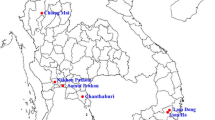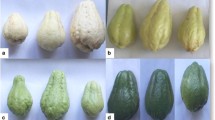Abstract
Morus spp., commonly known as mulberry, is significantly associated with human civilization and spread of silk-culture from Asia to Europe, Africa and Latin America. One of its species, Morus laevigata, traditionally well known for its timber value, forage use and silkworm's feed, is widely distributed in India extending from Himalayan foothill to Andaman islands. The variability occurring for 12 morpho-biochemical parameters and RAPD profiles, generated with 13 selected RAPD primers, for M. laevigata accessions from six different zones were investigated. Analyses revealed high degree of genotypic similarity of collection from Himalayan foothill (West Bengal) with those from Andaman Islands. Specific accessions from central India and south India also revealed genotypic similarities with specific accessions from north-east India. These observations are discussed in the context of clonal propagation of mulberry and evolutionary perspective of dispersal of this species, through human activities
Similar content being viewed by others
References
Armand, D. & M. Meuret, 1995. Culture en sec utilization en élevage de Morus alba 'kokuso 21' en provence Rapport Final (1991–1994). Selection and utilization of cultivated fodder trees and shrubs in Mediterranean extensive livestock production system. Institut National de la Recherche Agronomique, Avignon, France.
Arrieta-Montiel, M., A. Lyznik, M. Woloszynska, H. Janska, J. Tohme & S. Mackenzie, 2001. Tracing evolutionary and developmental implications of mitochondrial stoichiometric shifting in the common bean. Genetics 158: 851–864.
Ayana, A., E. Bekele & T. Bryngelsson, 2000. Genetic variation in wild sorghum (Sorghum bicolor ssp. Verticilliflorum (L.) Moench) germplasm from Ethiopia assessed by random amplified polymorphic DNA (RAPD). Hereditas 132: 249–254.
Bergmann, F., H.R. Gregorius & J.B. Larsen, 1990. Levels of genetic variation in European silver firs (Abies alba)–arethey related to the species' decline? Can. J. For. Res. 17: 519–526.
Brandis, D., 1906. Indian Trees. London.
Bryan, G.J., J. McNicoll, G. Ramsay, R.C. Meyer & W.S. De Jong, 1999. Polymorphic simple sequence repeat markers in chloro-plast genomes of Solanaceous plants. Theor. Appl. Genet. 99: 859–867.
Burkill, I.H., 1935. A Dictionary of the Economic Products of the Malay Peninsula. Crown Agents for the Colonies, London.
Cooley, W.W. & P.R. Lohnes, 1971. Multivariate Data Analysis. John Wiley & Sons, New York.
Crosby, A.W., 1986. Ecological Imperialism. Cambridge University Press, Cambridge, UK.
Dandin, S.B., R. Basavaiah, R. Kumar & R.S. Mallikarjunappa, 1995. Phyto-geographical studies in the genus Morus L. II. Geographical distribution and natural variation in M. laevigata Wall. Ex. Brandis. Indian J. Pl. Genetic Resour. 8: 129–131.
Das, B.C. & S. Krishnaswami, 1965. Some observation on interspecific hybridization in mulberry. Ind. J. Seric. 4: 1–8.
Datta, R.K., 2000. Mulberry cultivation and utilization in India. In electronic conference http://www.rao.org/ag/
Desplanque, B., F. Viard, J. Bernard, D. Forcioli, P. Saumitou-Laprade, J. Cuguen & H. Van Dijk, 2000. The linkage disequilibrium between chloroplast DNA and mitochondrial DNA haplotypes in Beta vulgaris ssp. Maritime (L.): the usefulness of both genomes for population genetic studies. Mol. Ecol. 9: 141–154.
Draakestein, R.T. & H. Van, 1678. Hortus indicus malabaricus. Vol. I, Amsterdam.
Duthie, J.F., 1960. Flora of upper Gangetic plain. Reprinted by Botanical Survey of India, India.
Dwivedi, N.K., N. Suryanarayana, B.N. Susheelamma, A.K. Sikdar & M.S. Jolly, 1989. Interspecific hybridization studies in mulberry. Sericologia 29: 147–149.
Facciola, S., 1990. Cornucopia: A Source Book of Edible Plants. Kampong Publications, pp. 391–392.
Farooqui, N., S.A. Ranade & P.V. Sane, 1998. RAPD profile variation amongst provenances of neem. Biochem. Mol. Biol. Int. 45: 931–939.
Ghosh, C.C., 1949. Silk production and weaving in India. Monograph. Council of Scientific & Industrial Research, New Delhi.
Gil, J. & A. Ron, 1992. Variation in Phaseolus vulgaris in the northwest of the Iberian Peninsula. Plant Breed. 109: 313–319.
Gomory, D., 1992. Effect of stand origin on the genetic diversity of Norway spruce (Picea abies Karst.) populations. For. Ecol. Manage. 54: 215–223.
Heilbron, I. & H.M. Bunbury, 1953. Dictionary of Organic Compounds. Eyre & Spottiswoode, London.
Hooker, J.D., 1885. Flora of British India. Vol. 431.L, Reeve and Co. Ltd, The East House Book, Ashford Kent, UK.
Howard, A.L., 1948. A Manual of the Timber of the World: Their Characteristics and Uses. Macmillan & Co. Ltd., London.
Hu, X.S., 2000. A preliminary approach to the theory of geographical gene genealogy for plant genomes with three different modes of inheritance and its application. Yi Chuan Xue Bao 27: 440–448.
Kitahara, N., 1999. Utilization of fodder tree for the production of milk and meat(3). Livestock Res. 53: 969–972.
Koidzumi, G., 1917. Contributions and Florum Asiae, Orientals. Bot. Mag. (Tokyo). 31: 31–41.
Lakhanpaul, S., S. Chadha & K.V. Bhat, 2000. Random amplified polymorphic DNA (RAPD) analysis in Indian mung bean (Vigna radiata L., Wilczek) cultivars. Genetica 109: 227–234.
Leslie, J., & V. Stevenson, 1985. Fruits for the Home and Garden. Angus and Robertson, pp. 173–176.
Linnaeus, C., 1747. Flora Zeylanica, Stockholm.
Miyashita, N.T., A. Kawabe & H. Innan, 1999. DNA variation in the wild plant Arabidopsis thaliana revealed by amplified fragment length polymorphism analysis. Genetics 152: 1723–1731.
Moeller, D.A. & B.A. Schaal, 1999. Genetic relationships among native American maize accessions of the great plains assessed by RAPDs. Theor. Appl. Genet. 99: 1061–1067.
Moti Chandra, 1977. Trade and Trade Routes of Ancient India. Abhinav Publications, New Delhi, India.
Mukeree, N.G., 1898. Handbook of Sericulture. Thacker, Spink & Co., Calcutta, India, pp. 298.
Nagaraja, G.M. & J. Nagaraju, 1995. Genome fingerprinting of the silkworm, Bombyx mori, using random arbitrary primers. Electrophoresis 16: 1633–1638.
Nikongolo, K.K., P. Michael & W.S. Gratton, 2002. Identification and characterization of RAPD marlers inferring genetic relationships among Pine species. Genome 45: 51–58.
Parkinson, C.E., 1923. A Forest Flora of Andaman Islands, edited by Bisen Singh & Mahindra Pal Singh, Dehra Dun, pp. 155.
Pearson, R.S. & H.P. Brown, 1932. Commercial Timbers of India. Central Publications Branch, Calcutta, India.
Rajora, O.P., 1999. Genetic biodiversity impacts of silvicultural practices and phenotypic selection in white spruce. Theor. Appl. Genet. 99: 954–961.
Rangaswami, G., M.N. Narasimhanna, K. Kasiviswanathan, C.R. Sastry & M.S. Jolly, 1976. Sericulture Manual – Mulberry Cultivation. FAO Agricultural Services Bulletin, Rome.
Rao, S.N., 2000. Molecular analysis of Nosema bombysis, a protozoan parasite of silkworm, Bombyx mori. PhD Dissertation, Mysore University, Mysore, India.
Ravindran, S., V. Anand Rao, V. Girish Naik, A. Tikader, P. Mukheerjee & K. Thangavelu, 1997. Distribution and variations in mulberry germplasm. Ind. J. Pl. Genet. Res. 10: 233–242.
Reich, I., 1991. Uncommon Fruits Worthy of Attention. Addison-Wesley, Reading, MA, pp. 173–183.
Rhys, D., 1903. Buddhist India. Published in London.
Sanchez, M.D., 2000. Mulberry, an exceptional forage available almost worldwide. Word Animal Review 93.
Tanksley, S.D. & C.M. Rick, 1980. Isozyme linkage map of tomato: application in genetics and breeding. Theor. Appl. Genet. 57: 161–170.
Tanksley, S.D., F.H. Medina & C.M. Rick, 1982. Use of naturally occurring enzyme variation to detect and map genes controlling quantitative traits in an interspecific backcross of tomato. Heredity 49: 11–25.
Thangavelu, K., P. Mukheerjee, A. Tikader, S. Ravindran, A.K. Goel, A. Anand Rao, V. Girish Naik & S. Sekar, 1997. Catalogue on mulberry (Morus spp.) Germplasm. Vol. I, Silkworm and mulberry Germplasm Station. Hosur, Tamilnadu, India.
Warmington, E.H., 1928. Commerce Between the Roman Empire in India. Cambridge University Press, UK.
Williams, J.G.K., A.R. Kubelik, K.J. Livak, J.A. Rafalski & S.V. Tingey, 1990. DNA polymorphisms amplified by arbitrary primers are useful as genetic markers. Nucl. Acids. Res. 18: 6231–6235.
Yadav, D.B.R. & T.P. Kumar, 1996. Occurrence of new distributional range of Morus laevigata, Wall and its variants in south India. Ind. J. Seric. 35: 163–164.
Author information
Authors and Affiliations
Rights and permissions
About this article
Cite this article
Chatterjee, S., Nagaraja, G., Srivastava, P. et al. Morphological and Molecular Variation of Morus laevigata in India. Genetica 121, 133–143 (2004). https://doi.org/10.1023/B:GENE.0000040384.24482.4b
Issue Date:
DOI: https://doi.org/10.1023/B:GENE.0000040384.24482.4b




